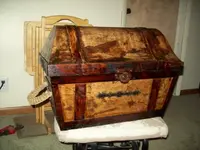Exactly the point...on documented evidence and contributing factors inherent to the need alone...there was 'something there'
No, I get your theory. On the surface, it makes sense logically. They're processing fish and they need salt. Importing salt is expensive. There's salt in the ocean. The ocean is right there. I understand that entirely.
What I'm having a problem with is the idea that they'd dig all of these trenches to direct seawater to a central location. I had some vague memories of how sea salt was recovered before modern times and I spent a bit looking into it today. My memories seem to have been correct for once. When you're using evaporation to concentrate your brine, you ideally want a warm climate, lots of sun, and large, shallow pools for the brine to sit in. The latter is particularly important. A well would not do the job. The rate of evaporation simply wouldn't be sufficient. Blocking off a very shallow lagoon might work, but then we no longer need any finger drains. Hauling buckets of seawater onto the beach to boil in a big kettle would work, but again, you don't need finger drains for that. This is the part that I'm having a problem with.
Touche to the salt mining. I haven't been able to find dates of the earliest eastern Canadian/US salt mines, and the more I look into the evolution of the process, it does appear costly pre-1850.
It was. You had to have an urgent need and the right location, with the right climate also being a plus. Even today, evaporating seawater for salt is not economically viable in most locations, and some of those locations only work because other minerals besides salt can be recovered. (Terrestrial saltwater from springs being evaporated to acquire lithium? I didn't know that! But I do now.)
The most economical method for getting salt is to mine it from the ground. It was true then and it's true today, interestingly enough. That's where the vast majority of it comes from. However, if you don't have salt deposits handy and your source of salt is expensive enough, it would certainly make sense to get it from the ocean if that were less expensive. What I find particularly interesting was that even in antiquity, when salt was far more expensive than it is today and people knew that you could get it from seawater, they still often bought it instead, even when it was right there and essentially free for the taking. It must have been a monumental pain in the ass to evaporate seawater if the conditions weren't just right.
One more quick thing about the non-presence of marine life in the caves. Marine life needs sunlight to survive.
No disrespect intended, but you don't work on ships, do you? Break open a seawater line and be amazed at all the little critters that have left their concretions all over the interior. Even in the sensitive stuff upstream of the filters, you'll find the little *******s everywhere. It probably won't be mussels and such (although it certainly can be!) but you'll definitely see those little calcium carbonate "tunnels" that some critter or another makes. No sunlight required, no sunlight desired.
I can tell you stories of the stuff that grows in potable water tanks, which is remarkable by itself. Imagine this: we take seawater, boil it down, condense the vapors into what's essentially freshwater (with a bit of carryover, but that's been boiled as well0, funnel it into an enclosed holding tank, and there's algea and crap growing in there after all of that. I can only imagine that it somehow came in through the vent or something, but how does algea even grow in water that's been distilled and is purer than what your public utility pipes to you? What's more interesting is that if you go through the trouble of scraping all of that crap out of the tank, the water will taste like an ass sandwich for a few months until the algea grows back. It's somewhat esoteric knowledge, but if you know someone that's in the trade, ask them. As Jeff Goldblum famously said in Jurassic Park, "Life finds a way."
That's why I made my somewhat final statement earlier: if there isn't evidence of critters there, there's not seawater there - not in significant amounts, anyway.
Growing up when I did, I was taught that Columbus was the first westerner to the New World, even though by that time it had already been established that he was not. I blame this on the dated books and the more dated curriculum at the school that I attended. Later on in life, I read that this was not the case. I looked further into it and realized that this lesson had been incorrect, and that Columbus had not been the first, or the second, or even the third. He had actually been pretty far down the list. The "first westerner in the New World" ship had sailed centuries before he'd been born, if not earlier.
I'm a pretty reasonable man. When confronted with proof that contradicts my beliefs, I change my beliefs to accomodate the proof - not vice versa. But those beliefs are based in proof, and proof is not catchy quotes that essentially sum up blind faith. That's an interesting quote though, in that it encouraged me to look up who Stuart Chase was and how he lived his life. I now understand why he would have written such a thing. The guy was not writing about treasure legends when he came up with that, but he was wrong nonetheless.
If that's your argument here, have at it. If that's not your argument here, you may wish to consider a more appropriate quote.









